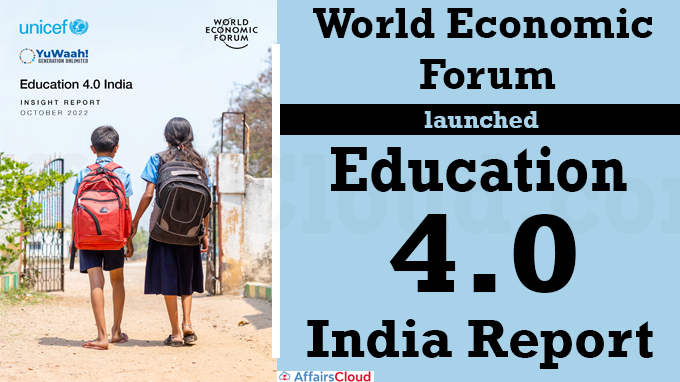
According to the report titled “Education 4.0 Report” 2022, released by the World Economic Forum (WEF), the school-to-work (S2W) transition process in India is still facing severe challenges, and a lack of coordinated efforts has resulted in an isolated skilling system that has not been able to reach its full potential.
- The “Education 4.0 Report” outlines how digital and other technologies can bridge learning gaps and make education accessible to everyone.
WEF: Education 4.0 India Initiative
i.The WEF launched the ‘Education 4.0 India’ initiative in partnership with the United Nations Children’s Fund (UNICEF) and YuWaah (Generation Unlimited India).
- It was established in May 2020 and has brought together more than 40 partners from the education, technology, government, academic, and start-up communities.
- Objective: To observe how Fourth Industrial Revolution technology can improve learning and eliminate inequalities in access to education among Indian schoolchildren.
ii.The “Education 4.0 Report” identifies gaps and suggests interventions under four themes: foundational literacy and numeracy; teacher professional development; S2W transition; and connecting the unconnected.
- It provides solutions with 5 essential building blocks: curriculum, content, capacity, community, and digital infrastructure.
Summary of the Report
i.There are more than 60 million secondary and higher secondary students in India, yet only 85% of schools have included vocational courses in their curriculum.
ii.Major obstacles for the school-to-work (S2W) transition process include: lack of trainers; inadequate infrastructure and resources; poor integration with the mainstream academic curriculum and poor connections between localized skill needs & vocational courses.
- The term “S2W transition” refers to the process of preparing students job-ready in a rapidly changing labour market.
iii.The report complements the National Education Policy 2020 (NEP 2020) of India and the National Digital Education Architecture of 2021.Several online education platforms and tools are also available, such as DIKSHA (digital infrastructure for school education), ePathshala (a portal/app that provides access to educational resources), SWAYAM (a platform for massive open online courses or MOOCS) and Samagra Shiksha Abhiyan (an overarching programme for schools).
- Meanwhile, the Padhe Bharat (“India learns”) campaign focuses on improving reading proficiency among children to improve learning.
Other Relevant Data
i.According to the National Achievement Survey (NAS) of 2021, the average learning level was 59% in grade 3, 49% in grade 5, 42% in grade 8, and 36% in grade 10.
ii.Using digital and other technologies, the Knowledge and Information Network for Digital Learning and Education (KINDLE) seeks to close learning gaps and provide access to education for all people.
Recent Related News:
i.The WEF ranked India at 135 out of 146 countries in its Global Gender Gap (GGG) Index for 2022.
ii.The gender gap is the difference between women and men as reflected in social, political, intellectual, cultural, or economic attainments or attitudes. In 2021, India was ranked 140 out of 156 countries.
About World Economic Forum(WEF):
Founder & Executive Chairman – Professor Klaus Schwab
Establishment – 1971
Headquarters – Geneva, Switzerland




